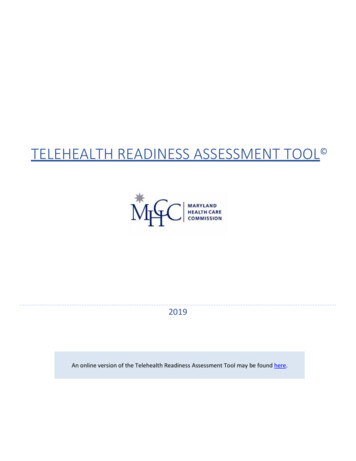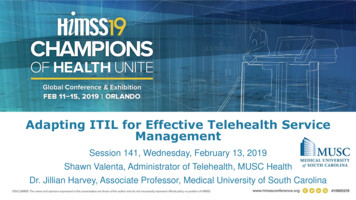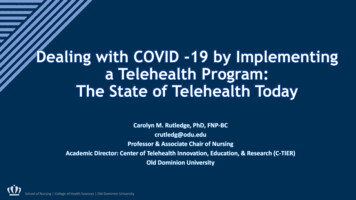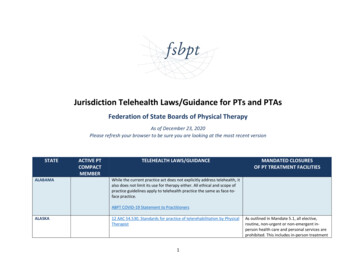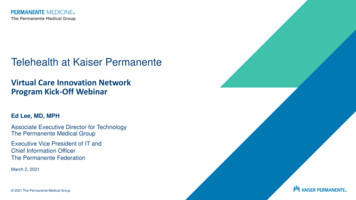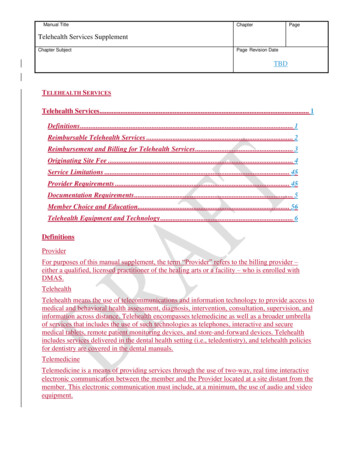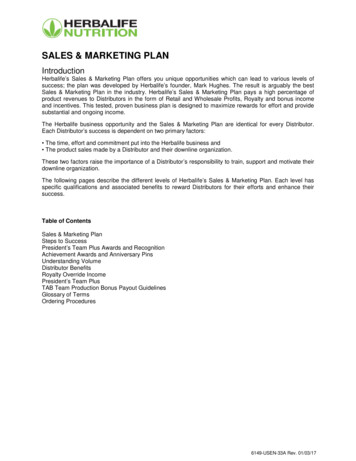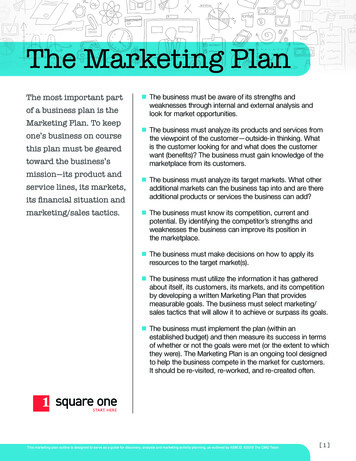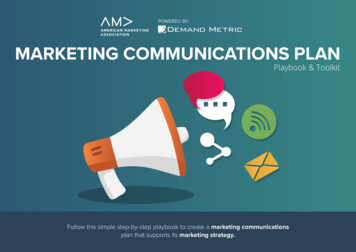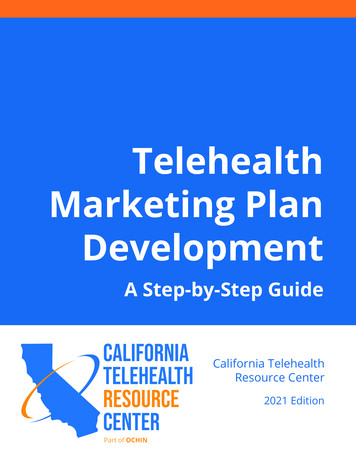
Transcription
TelehealthMarketing PlanDevelopmentA Step-by-Step GuideCalifornia TelehealthResource Center2021 Edition
Telehealth Marketing Plan Development: Step-by-StepINTRODUCTIONThere are many ways to prepare a telehealth marketing plan. Some plans serveas a high-level strategic overview. Others are built around detailed analytics thatcarefully assess market segmentation, audience targeting, industry positioning,and more.Trying to choose the right scope and format for your plan can be incrediblytime-consuming. This is not the kind of challenge you welcome when your mainfocus is actively driving telehealth awareness, increasing utilization, boostingprogram reputation, and propelling long-term growth.This guide takes a different approach. It features a template you can easilyadapt and modify to suit your specific program needs. That makes it useful andversatile for many different program types—from small rural clinics, to largecommunity hospitals, and practically everyone in between.Let’s start by assuming that fictitious XYZ Regional Medical Center (RMC) hasalready received approval to start its telehealth program. XYZ RMC’s marketingplan becomes a key component in a broader strategy geared toward successfullong-term program implementation and sustainment.Find XYZ RMC’s sample plan included in this guide, starting on page 8. Youcan customize the various sections to fit your own unique situation. We startby explaining the purpose behind each section, so you can decide exactly howmuch to include. Substitute your program’s specific details and figures, andhave a usable marketing plan ready to go in no time.Need some effective insights about promoting your telehealth program tocurrent and prospective patients, or the community at large? Those are includedas well, starting on page 29.If you would like additional support, call the California Telehealth ResourceCenter (CTRC) toll-free at 877-590-8144. You can also visit caltrc.org for a widerange of telehealth insights, no-cost training tools, and unbiased resourcesdesigned to help you work smarter. If a certain approach has worked especiallywell for you, please share it with us! CTRC 2021This document is made possible by grant number G22RH20249 from the Office for the Advancement of Telehealth,Health Resources and Services Administration, DHHS. This information or content and conclusions are those of theCTRC and should not be construed as the official position or policy of, nor should any endorsements be inferred byHRSA, HHS or the U.S. Government.2
Telehealth Marketing Plan Development: Step-by-StepPLAN COMPONENTSThe overview below describes some of the key sections you should considerincluding in your marketing plan. They are grouped by general purpose andfunction, to help you decide what works best for your individual circumstances.Including every segment shown verbatim is not necessarily required. Remember,you want to give readers an overall sense of strategic context and tacticalexecution.Prefer to create your own marketing plan from scratch? These descriptions canguide your process. If you get stuck for ideas, try using the Sample MarketingPlan provided later in this guide. Just copy and modify the XYZ RMC illustrativetext to suit your needs. Key plan components are as follows:1ESTABLISHING CONTEXTExecutive SummaryThis section is intended for busy executives and lead stakeholders whodo not have time to read through the entire marketing plan. They candetermine goals, audience targets, budgetary allowances, key activities, andperformance metrics by skimming this summary. It’s usually brief, and oftenbulleted.IntroductionThis brief section summarizes what your marketing plan will cover. It canintroduce telehealth program goals, mention reasons for putting the plantogether, and provide general context for the various other sections.BackgroundThis section adds a bit more business context. Describe the circumstanceswithin which your marketing activities will take place. What have youaccomplished to date? What new products and/or services are beingprovided? How do these fit into your broader service offerings?3
Telehealth Marketing Plan Development: Step-by-StepPLAN COMPONENTS, continued2OUTLINING GOALSStrategic ObjectivesThis section lays out specific, measurable goals related to the telehealthproduct or service you offer. Your operational, marketing, and technicalstrategies support these primary objectives. For business goals, consideraddressing categories like financial concerns, market share/leadership,reputation, mission, and operational effectiveness. For clinical goals, consideraddressing patient care, clinical support, and participation. Whereverpossible, explain how success metrics will vary from one year to the next.Marketing ObjectivesDescribe the key goals of your marketing activities. Just as with the broaderstrategic objectives, include success metrics for each marketing initiative.Marketing Strategy: OverviewThis section summarizes the major elements of your marketing strategy.Subsequent sections will explain these elements in greater detail, addingmarket analysis that supports strategic direction. These core elements areoften labeled “Segmentation,” “Targeting,” and “Positioning.” You can alsoconsider using the descriptors “Market,” “Message,” and “Media.” Thelabels you choose will drive the remainder of your marketing plan.Marketing Points to Ponder:In a 2020 survey, 46% of respondents said theirmain motive for choosing a telehealth visit was“safety.” Overall, this represented an increase ofjust 13% from the previous year. Source: J.D. Power U.S. Telehealth Satisfaction Study4
Telehealth Marketing Plan Development: Step-by-StepPLAN COMPONENTS, continued3ANALYZING AUDIENCEMarket Analysis: Target MarketUse this section to answer important questions like: Who is our target audience (i.e., who are we trying to reach)? How do we identify and segment this audience? Who are we targeting with each campaign and/or tactic outlinedin our marketing plan? Why have we chosen these targets, versus others?Market Analysis: Audience Pain PointsRemember, the people you are trying to reach should identify with yourmessage. Spend time assessing their challenges and/or needs. Next, identifythe unique and singular ways telehealth could resolve those challengesand/or needs. Analyze each specific target market. Drill down to the “painpoints” for each targeted group—the areas of discomfort you want to helpthem resolve. Also take into account alternate solutions that might exist, soyou can clearly articulate the reasons why telehealth represents the betterchoice.5
Telehealth Marketing Plan Development: Step-by-StepPLAN COMPONENTS, continued4DETAILING APPROACHMessageSynthesize your market analysis elements into guiding messages that formthe foundation of your marketing materials. Start defining the actual wordsand phrases you will use to address each audience. How is your programdifferent than alternatives? What beneficial claims can you make andsubstantiate? Be sure all claims related to health care are defendable. Forexample, you cannot guarantee patient outcomes—but you can promoteyour solution as having demonstrated certain outcomes.ResourcesIdentify the resources available to support your key marketing activities.These elements might include people, spaces, budget dollars, raw materials,automobiles, storage areas, patents, partnerships, and/or databases. Theyare things that help you execute on time, within budget, and according totargeted goals.MediaWhat modalities will you use to convey your message—digital, print, video,social platforms, or something different? Explain why specific modalities oractivities have been chosen over others.Marketing Points to Ponder:In a recent U.S. study, overall patient satisfactionwith telehealth scored 860 on a 1,000 point scale.52% of respondents said they faced at least onebarrier to telehealth access. Source: J.D. Power U.S. Telehealth Satisfaction Study6
Telehealth Marketing Plan Development: Step-by-StepPLAN COMPONENTS, continued5DESCRIBING ACTIVITIESMarketing Activities: SummaryProvide an overview of key marketing activities. Include information that canhelp facilitate comparisons across each initiative. Begin with a description,and outline core objectives. Reiterate your target audience; then spell outfrequency, resources, and essential metrics for success.Marketing Activities: DetailsSome activities may require a longer explanation. For instance, if you arelaunching a new website or trying out a new social media platform, youmay want to explain the different types of navigation, forms, and/or contentyou plan to include. You may wish to outline this in a phased approach (bymonth, or by business quarter).6SUMMARIZING NUMBERSSuccess MetricsYou should always aim for measurable results. This encourages your entireteam to assess, learn, and adjust your approach over time. In this section,you want to point back to your marketing activities summary. Outline keysuccess metrics in aggregate (since some metrics will be impacted by multipleactivities). Explain the targeted value of these metrics, and the various activitiescontributing to each.FinancialsSummarize the financial investment associated with your marketing activities.If possible, break this out in various ways—by month, by medium, and/or bycapital costs versus operating costs.7
Telehealth Marketing Plan Development: Step-by-StepXYZ Regional Medical CenterSample Marketing PlanTable of ContentsExecutive Summary. 9Introduction. 10Background. 10Strategic Objectives. 10Business. 11Clinical. 11Marketing Objectives. 12Market Strategy: Overview. 12Market Analysis: Target Market. 13Market Analysis: Challenges/Alternatives/Benefits. 14Hospital Administration & Staff. 15Referring Providers. 16Patients.17Supporting Organizations: Employers. 18Supporting Organizations: Churches & Charities. 18Message. 19Sample Headlines. 20Resources. 20Team. 20Financial. 20Media. 20Marketing Activities. 21Marketing Activity Details. 22Overview Table. 23Website. 24Newsletter. 25Brochure. 25News Releases/Guest Articles. 25Connected Health Media Day. 25Satisfaction Survey. 26Social Media. 26Face-to-Face Visits. 26Success Metrics. 27Financials. 288
Telehealth Marketing Plan Development: Step-by-StepXYZ Regional Medical CenterSample Marketing PlanExecutive SummaryNotes: This section is intended for busy executives who may not have time to review the marketingplan in its entirely. It therefore summarizes key details—including goals, target audience(s), budget,action items, and success metrics—in a shortened, easy-to-skim format.This marketing plan is intended to increase the visibility, adoption, and use of new telehealthservices for XYZ Regional Medical Center (XYZ RMC). Our marketing campaigns will primarilytarget: The patient community Referring providers Internal administration and staffWe will be working with an operating budget of 1,550 for the fiscal year ending in December.These funds will be invested in the following activities: Website Digital newsletter Brochures for patients Media activities—news releases, guest blogs, op-eds, and topical pitches Satisfaction surveys from patients, providers, and administration Social media campaignsThe following items will represent our primary measures of success: Targeted 1,000 website visitors per month Targeted 250 newsletter subscribers by Q2 Targeted patient satisfaction score of 90% within the first year Targeted 75% of administrators able to identify at least three telehealth program benefitswithin the first six months9
Telehealth Marketing Plan Development: Step-by-StepXYZ Regional Medical CenterSample Marketing PlanIntroductionThis document describes the marketing plan for XYZ RMC’s telehealth program. It coversmarketing strategy, marketing tactics, success metrics, and financials. All major marketingactivities are summarized and described in the Marketing Activities section for quick reference.BackgroundNotes: This section provides marketing plan context. Describe the circumstances under which yourmarketing activities will take place. Summarize what has already been accomplished, and theproduct(s) or service(s) being offered. This puts your marketing plan into a larger business framework.XYZ RMC has recently committed to participate in the California Telehealth Network (CTN).We will utilize CTN services to provide patients in Alphabet County with a new suite of clinicalservices via telehealth.Our telehealth offerings will include both emergency and non-emergency services. Non-emergency services: cardiology, dermatology, gastroenterology, infectious disease Emergency services: neurology/strokeTelehealth technology for broadband services and videoconferencing was originally obtainedthrough grant funding from Generous Organization of America.Strategic ObjectivesNotes: While the above section provided business context, this section lays out specific strategicgoals that can be measured. These goals should relate to the telehealth product(s) or service(s) youare offering. It is helpful to group related goals into categories (such as “business” and “clinical”).Your operational, marketing, and technical plans will ultimately support these primary goals.We would like to encourage participation in this program so that XYZ RMC sees a returnon its new investment—while in the process, providing better care for our valued patientpopulation. Please review the following pages for details.10
Telehealth Marketing Plan Development: Step-by-StepXYZ Regional Medical CenterSample Marketing PlanStrategic Objectives: BusinessNotes: Use this subsection to outline goals that involve financial concerns, market share, marketleadership, industry reputation, facility mission, and operational effectiveness. Where possible,identify when these goals should be achieved and how success metrics will vary from year to year.OBJECTIVETIME FRAMEThe hospital’s CEO, CMO, and CTO will be able toidentify top benefits that the telehealth program isbringing to the medical center.Within 6 months of program launchThree external community organizations will haverecommended the telehealth program to their members.Within the first yearPatient satisfaction with the telehealth program will exceed90%.Within the first yearThe telehealth program will earn positive media coverage.Within 6 months of program launchMeasurable program-related return on investment (ROI).Within the first yearStrategic Objectives: ClinicalNotes: Use this subsection to outline any goals applicable to the areas of patient care, clinical support,or program participation. Indicate your planned time frame, wherever possible.OBJECTIVETIME FRAMEAchieve 100 telehealth encounters.Within the first year10 clinicians will obtain telehealth training andearn CE credit on topics related to our supportedtelehealth specialties.Within the first yearWe will change at least one patient’s life by reducing waittime significantly, minimizing time taken off work to see aspecialist, or providing a diagnosis that meaningfullyalters the patient’s outcome.Within the first yearClinician satisfaction with our telehealth program willexceed 80%.Within the first year11
Telehealth Marketing Plan Development: Step-by-StepXYZ Regional Medical CenterSample Marketing PlanMarketing ObjectivesNotes: This section describes the marketing plan’s key objectives. Just as with the broader strategicobjectives, include success metrics for each marketing goal you indicate.Our marketing efforts will support the telehealth program’s broader objectives by: Increasing program visibility and awareness, both internally and within our community. Driving internal program support. Administrators will continue funding the program andadvocating its use. Physicians, nurses, and other clinicians will utilize the program. Driving use of our new telehealth services by both patients and referring providers. Growing our reputation through media coverage, testimonials, and success stories.Please see the section titled “Success Metrics” for specific measures of success, along withassociated marketing activities and branding campaigns.Market Strategy: OverviewNotes: This section summarizes the major elements that comprise your marketing strategy. Subsequentsections will outline these elements in detail, providing market analysis that supports your strategicdirection. Most business schools suggest designating these major initiatives as “Segmentation,”“Targeting,” and “Positioning.” You could also label your categories “Market,” “Message,” and“Media.” Remember that the names you choose will drive other sections of your plan.Our marketing strategy is designed around these three core elements: Market—to whom do we want to speak? Message—what do we want to tell them? Media—how do we want to get that message across?Please see the next several sections for a detailed analysis.12
Telehealth Marketing Plan Development: Step-by-StepXYZ Regional Medical CenterSample Marketing PlanMarket Analysis: Target MarketNotes: To whom are you planning to speak? How will you divide up that audience? Whoare the targets of your various marketing campaigns? Why have you selected those targetsversus others? These are the types of questions to address in this section.In Figure 1, we have identified numerous groups that could influence the use and reputationof our telehealth program. The size of each rectangle directly corresponds to degree ofpotential influence. Arrows indicate the direction of that influence. Based upon this illustration,it appears that the Telehealth Director could potentially impact multiple other influencers.Although Figure 1 does not address this particular dynamic, it’s worth noting that numerousentities actually influence the patient’s decision to accept and use telehealth as an alternativeto in-person care. Such influencers include the news media; various referring providers; andsupporting organizations like employers, churches, and charities.For our initial marketing strategy, we will select a few entities that seem to have the mostdirect influence on program awareness and successful utilization.XYZ Regional Medical LegislatorsFigure 1Key audience groups that could influence the use and reputation of our telehealth program.13
Telehealth Marketing Plan Development: Step-by-StepXYZ Regional Medical CenterSample Marketing PlanMarket Analysis: Target Market (continued)The target audiences for our marketing efforts are: Hospital administration and staff: These individuals can help us execute our telehealthprogram through funding, advocacy, and program participation. Referring providers: We would like providers to participate by recommending ourtelehealth program to their patients. The group should consist of hospital staff members,referring primary care physicians, and/or clinicians at local nursing homes and longterm care facilities. Supporting organizations: These organizations will serve as channel advocates whopromote our telehealth services to their members. They can include local employers,churches, charitable agencies, and patient advocacy groups that have close relationshipswith the community population (and therefore, potential insight into various health carechallenges). Patients: Ultimately, we would like this group to take advantage of our telehealth services.Figure 1 also suggests that local media can have a sizable influence on hospital administrators,legislators, supporting organizations, and referring providers. Our marketing strategy willtherefore focus on leveraging media involvement to advocate for telehealth with these otherkey influencer groups.Market Analysis: Challenges/Alternatives/BenefitsNotes: Once you have selected your marketing targets, consider what you want to tell them. Beforemaking the potential mistake of jumping right into a discussion about telehealth, identify their specificchallenges (i.e., “pain points”). Also consider the options they have for addressing these challenges.Then identify the unique ways your telehealth program can offer beneficial insights, alternatives,and/or resolutions. Make sure your analysis is specific to each target market. A generic effort doesnot normally assess pain points with enough specificity to identify persuasive advantages.In this next section, we will review our key target audiences in terms of the challenges they (ortheir constituents) face. We will detail available alternatives for addressing those challenges.Then, we will outline the unique benefits our telehealth solution can bring to the table.14
Telehealth Marketing Plan Development: Step-by-StepXYZ Regional Medical CenterSample Marketing PlanMarket Analysis: Challenges/Alternatives/Benefits (continued)This section is critical because: Challenges help us understand what is really troubling each target audience—andrecognize what causes “pain” or stress to each particular audience. The way(s) ourtelehealth solution alleviates these challenges will translate into our mainmessage points. Alternatives identify areas that directly compete with our telehealth solution. This helps usto assess our relative strengths and weaknesses, and to fine-tune our message points. Benefits represent key gains or advantages our various audiences perceive regardingthe use of our telehealth solution. Several of these benefits may overlap across multipleaudiences. Our ongoing objective is to identify benefits associated with relieving thechallenges mentioned above.Hospital Administration & StaffChallenges It is difficult to attractspecialized health careresources needed to servethe community effectively. Hospital’s fiduciaryresponsibilities areincompatible withthe cost of providinghighly specialized care. Patients from thecommunity end up atmore sophisticated carefacilities, because theycannot be served at theRMC.Alternatives Continue to provide thesame limited level ofhealth care services. Sacrifice profits and/or other expenses to hireadditional specialists. Accept the ongoing riskthat patients will chooseto go elsewhere for theirhealth care needs.Telehealth Solution Benefits Provides better health careservices to the community. Keeps patients at ourfacility, rather thantransferring them out forspecialized provider care. Retains revenues forproviding care to the localcommunity. Shows the community thatits local hospital providesaccess to leading edgetechnology and services. Demonstrates effectivehospital stewardship.15
Telehealth Marketing Plan Development: Step-by-StepXYZ Regional Medical CenterSample Marketing PlanMarket Analysis: Challenges/Alternatives/Benefits (continued)Referring ProvidersChallengesAlternatives Patients need the help ofspecialists who do notpractice in our localcommunity. Keep patients local, withlimited access tospecialists. Allows patients to remainlocal and avoidsunnecessary transfers. Send patients to distantfacilities for care ortreatment—whichpotentially impacts theirquality of life due to longcommute times, delayedappointments, oroutright refusal to go. Allows patients to seea specialist more quickly,potentially reducing waittimes from months todays. Patient care plans andtreatments are delayeddue to lack of time,resources, and/or funds tosee specialists with thenecessary diagnosticexpertise. Some patients are lost toother providers and/orfacilities, because thosepatients need to bereferred out for care.Telehealth Solution Benefits Facilitates fasterdiagnosis, therebycreating more effectivepatient treatment plans. Uses technology on theleading edge of healthcare. Retains patients andassociated revenues.16
Telehealth Marketing Plan Development: Step-by-StepXYZ Regional Medical CenterSample Marketing PlanMarket Analysis: Challenges/Alternatives/Benefits h Solution Benefits Lingering health careissues for which patientscannot receive local help. Try in vain to finda local practitioner whocan help. Care delayed becausepatients cannot afford todrive hundreds of miles(or several hours) to seea specialist. Delay care and live withthe problem until thesituation deteriorates,thereby requiring hospitaladmission and/or lengthytravel for specialized care. Provides access tospecialists who don’tpractice locally, but havethe skill set necessary toaddress the problem. Care delayed due tolengthy specialist waittimes of weeks or months. Reluctance to travel longdistances and potentiallyleave behind their supportnetwork if prolongedtreatment is necessary. Eliminates or significantlyreduces long wait timesto see specialists. Avoids expensive travelcosts (time off work, gasmoney, mileage on car,time away from family,etc.) Takes advantage oftechnology at theleading edge ofhealth care. Reluctance to put undueburden on supportnetwork, who may taketime off work and/ortravel long distances tobe near patient.17
Telehealth Marketing Plan Development: Step-by-StepXYZ Regional Medical CenterSample Marketing PlanMarket Analysis: Challenges/Alternatives/Benefits (continued)Supporting Organizations: EmployersChallengesAlternatives Employees struggle withhealth problems theycannot resolve, whichimpacts their well-beingand/or productivity. Let employees live withtheir health-relatedchallenges. Helps employees stayhealthier and moreproductive. Let their employers sufferthe consequences. Reduces the need to taketime off work for sickleave. Employees take time offfor sick leave, whichdisrupts shift schedules,decreases production,and/or increases costs. Explore legal waysto replace these ailingemployees.Telehealth Solution Benefits Increases reliability andpredictability of employeeattendance.Supporting Organizations: Churches & CharitiesChallenges Members share healthissues that are negativelyimpacting home/work life,and the organization isunable to recommendhelpful communityresources.Alternatives Provide consolation andresources to help patientsdeal with varioussymptoms of the issue,but not the actual rootcause.Telehealth Solution Benefits Members address andresolve their healthrelated issues morequickly, thereby feelingbetter and experiencingfewer home/work/lifestylechallenges.In summary, our telehealth program is well-positioned to provide a range of advantages forour various audiences. The primary alternative (i.e., the status quo) does not provide muchbenefit, and may lead to additional challenges over time.18
Telehealth Marketing Plan Development: Step-by-StepXYZ Regional Medical CenterSample Marketing PlanMessageNotes: Consolidate the elements from your Market Analysis into guiding messages that will helpdrive your marketing materials. This step brings you closer to “copy”—actual words you will use inyour various marketing vehicles. Consider how you would like to attract your target audience, andhow you can distinguish your offerings from other alternatives. What justifiable claims can you make?Because you are providing a health care solution, make sure all claims are defendable. Remember:You cannot guarantee patient outcomes, but you can say that your solution has demonstrated certainoutcomes.To earn target audience interest, our opening message will ask questions related to specificaudience challenges. Sample copy points are shown below.Patients Do you have a persistent or chronic health care problem? Are you delaying care because you cannot .1. afford time off work for that three-hour commute to visit the specialist?2. even get an appointment to see the specialist until June of next year?3. bear the thought of leaving friends/family behind, or creating
This document describes the marketing plan for XYZ RMC's telehealth program. It covers marketing strategy, marketing tactics, success metrics, and financials. All major marketing activities are summarized and described in the Marketing Activities section for quick reference. Background Notes: This section provides marketing plan context .

